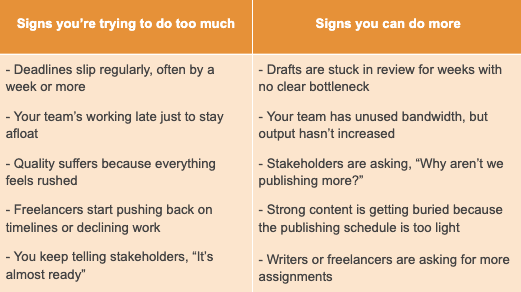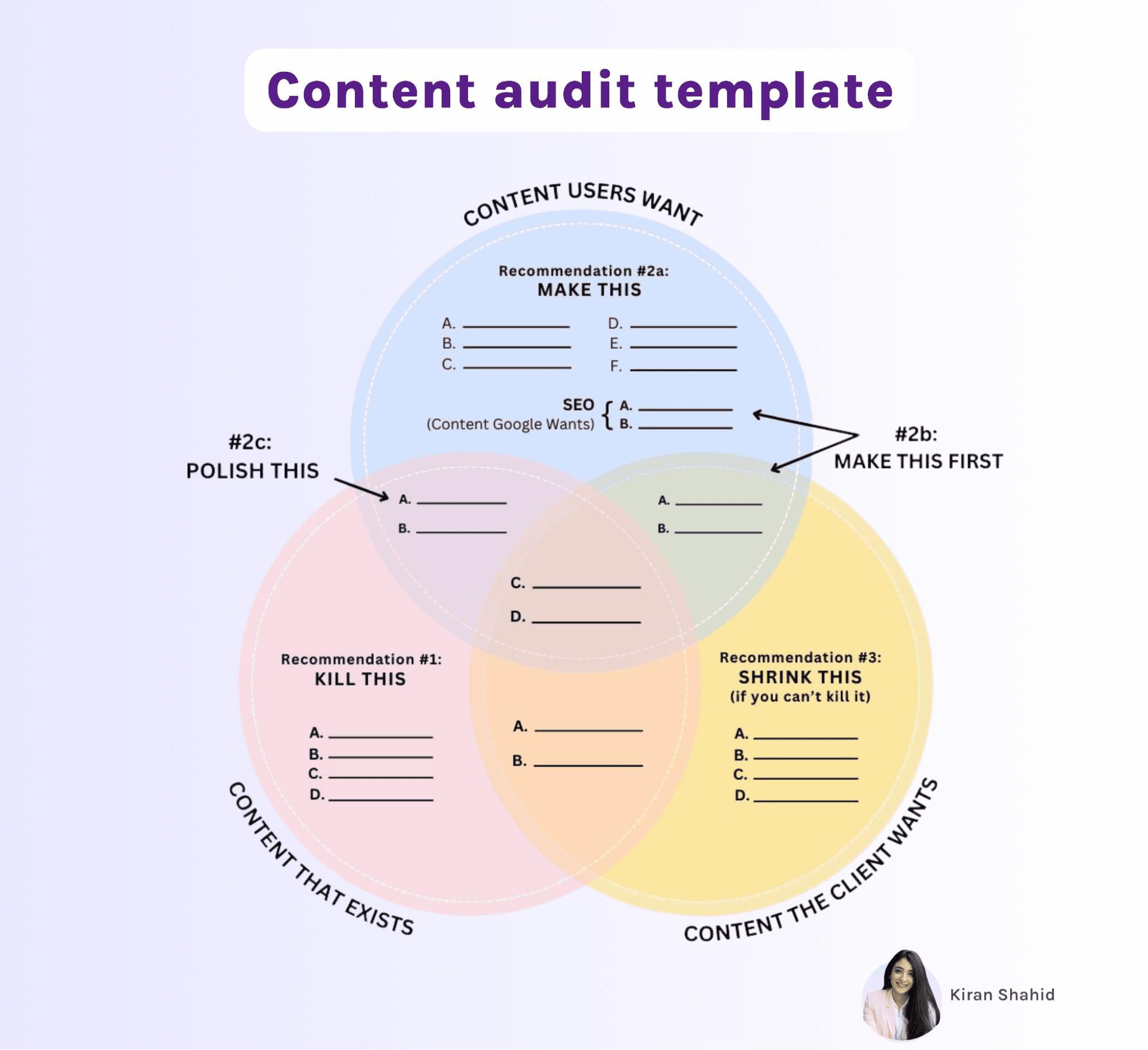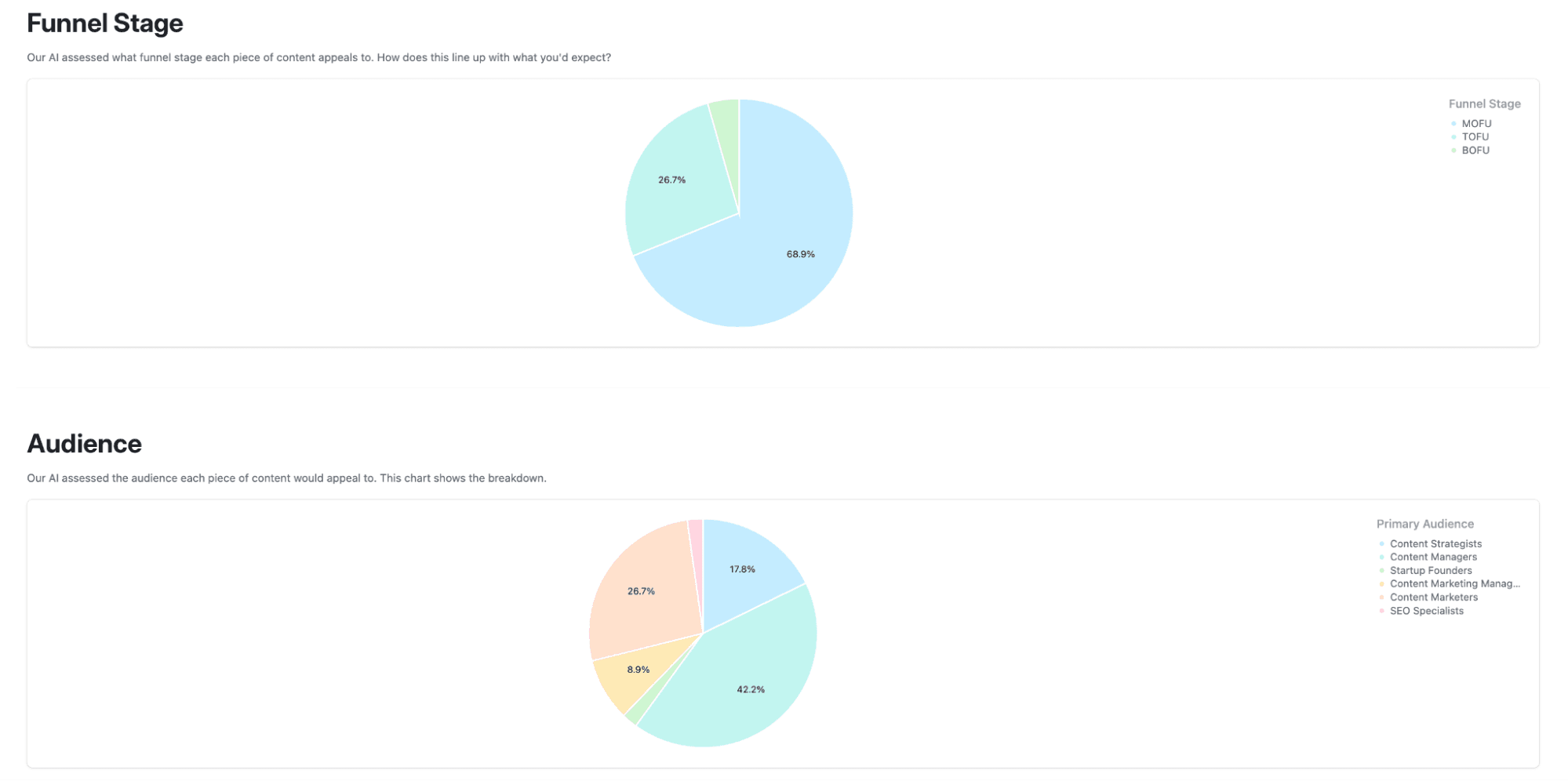How to Run Quarterly Content Strategy Check-Ins to Save You From Constant Firefighting
Quarterly check-ins keep content strategies aligned with business goals. A structured 60-minute review surfaces drift early and redirects focus to impact. Teams that turn outcomes into briefs and calendars keep their strategy active in daily work.

Your content strategy started strong. Three months ago, it felt focused and perfectly aligned with your goals.
Now, several months have passed, and priorities have shifted. Your CEO wants more thought leadership, sales needs new case studies, and that cornerstone piece you planned? Still sitting in draft mode.
Your team is working hard, but the output no longer matches the original plan. You set out to create thought leadership and evergreen pieces — now you’re pushing out quick-turn assets to meet shifting demands.
Kay-Kay Clapp, Head of Content and Social at online form-building platform Typeform, puts it perfectly:
"You might have the best distribution plan in the world. You might have prepped social assets, internal rollouts, cross-channel support — all the right things. But sometimes, the smartest move is to pause, watch how people react, and then build your strategy off that."
“Sometimes, the smartest move is to pause, watch how people react, and then build your strategy off that.”
You don’t need a full overhaul. Just a focused, 60-minute quarterly check-in to realign your content with your goals and team capacity.
In this article, we’ll break down what to review, how to gather team input, and share a plug-and-play agenda you can use next quarter, plus practical tips from content managers who've navigated these quarterly pivots.
First things first: strategy drift is normal
Strategy drift happens when your team is paying attention to your business, your buyers, and your market.
Lee Densmer, a B2B content strategy expert who’s worked with over 20 clients in the past three years, puts it clearly:
"I see teams who are too busy putting out fires to build the fire escape. This usually means they are just creating and creating and haven't put any guardrails in place. You have to build the fire escape – and this is the strategy."
“I see teams who are too busy putting out fires to build the fire escape.”
Not sure if you’re off track? These are the telltale signs your strategy has quietly drifted:
- Content doesn’t reflect new features or product updates
- SEO strategy targets outdated keywords and search behaviors
- Publishing schedule ignores real team capacity
- Personas and messaging no longer match actual buyers
- Strong engagement, but content isn’t resonating in sales calls
If these warning signs sound familiar, you’re not alone. Take time tracking platform Toggl, for example — their team saw exactly how unchecked drift can erode even a strong content foundation.
Volatility in rankings. A dip in traffic. A growing sense that their audience had evolved and their content hadn’t kept up. Small gaps were starting to show, and it was clear that surface-level tweaks wouldn’t be enough.
As Elizabeth Thorn, Senior Content Manager, explains:
“We knew small tweaks wouldn’t cut it. Search intent had shifted, and algorithms prioritized experience-driven content. We weren’t aligned anymore. Other brands were leaning into industry-specific formats we hadn’t yet adopted.”
Toggl's experience isn't unique. Countless content teams are wrestling with the same tension right now. Strategy that felt solid six months ago suddenly feels out of step with reality.
Even teams that stay on top of industry changes can get caught off guard.
Elizabeth adds: "We’ve talked about this a lot internally, but I don’t think any of us fully anticipated how dramatically search would change over the past 6 to 12 months. We’ve always stayed on top of AI trends and done regular audits and reviews, but even with all that, we were still surprised by how much we need to rethink our search strategy now to stay competitive."
“We’ve always stayed on top of AI trends and done regular audits and reviews, but even with all that, we're still surprised by how much we need to rethink our search strategy now to stay competitive.”
The good news? You just need a structured check-in to review your goals, assess performance across key channels, and realign your roadmap. A smarter content operations system wouldn't hurt either.
Why are quarterly check-ins the best frequency?
Monthly reviews lead to constant tweaks with no time to execute. Annual reviews let priorities drift for too long.
Quarterly gives you enough time to act and measure results, without falling behind.
Quarterly timing also syncs naturally with business cycles. Most companies run quarterly planning, budget reviews, and goal-setting sessions. Your content strategy check-ins can feed into (and learn from) those broader conversations.
Elizabeth has been running this cadence for years:
"We've always been pretty diligent about quarterly retros. Typically, that's meant revisiting KPIs, looking at audience behavior changes, and assessing what's working in real time before we lean too heavily into a type of content or niche segment in following quarters."
Here’s what a quarterly check-in could look like:
- A 60-90-minute Zoom or hybrid meeting with marketing, content, and key stakeholders
- A shared Google Doc or Notion template to log performance metrics, audience shifts, and priority changes
- A single slide to align on what’s working, what’s lagging, and what needs to be adjusted
- Optional input from sales or product teams to reflect evolving business priorities
The goal is simple: leave the session with two to three clear shifts to your priorities, content formats, or workflows based on performance data, evolving audience behavior, or shifting business needs.
What to review every quarter (and what to skip)
Think of quarterly check-ins as a routine health check for your strategy. You’re keeping your plan aligned with what’s actually happening, without wasting the effort you’ve already put in. Check these four areas to confirm what’s working, spot what’s off, and make small, targeted adjustments.
Performance: Which topics or formats are working? What’s underperforming?
Performance covers both the numbers (traffic, conversions, rankings) and the signals behind them (sales team insights, customer questions, social shares). You want to identify which content drives pipeline, supports sales, or improves retention.
Elizabeth explains: "The first step is a full audit. We look at performance data to identify top-performing assets and recurring content types that consistently help us meet our goals. Those become the 'keep' pile."
But Nikki Canning, ex-Director of Content at social media platform Later, warns against getting caught up in vanity content ROI metrics:
"My top piece of advice here is to look beyond the obvious numbers. Of course, you're likely tracking things like 'organic search visits' or 'total page views' that ladder up to wider business goals, and absolutely keep tracking those to show you're hitting objectives. But when it's time for your quarterly content strategy check-in, you need to dig deeper."
“My top piece of advice here is to look beyond the obvious numbers.”
Nikki suggests reviewing the following:
- Content-to-conversion pathway performance: "Are people who engage with your content actually moving toward your business goals? Track whether your content audience becomes your customer audience. If your blog gets tons of engagement but those readers never convert, you've got a strategy problem."
- Content engagement quality vs. quantity: "Look at completion rates, return visitors, and cross-platform relationship building. Someone who reads your full article, saves it, and then follows you on LinkedIn is worth 100 times more than 100 people who click and bounce. If your engagement numbers look great but people aren't consuming your content or building relationships with your brand, your strategy isn't working."
- Audience-content alignment: "This is where you check if you're attracting the right people in the first place. I once worked with a client who had super-engaged followers who loved our content and events but never bought anything. Turns out our content strategy was working, but for the wrong audience. Your content should attract people who can and will become customers, not just people who enjoy what you create."
Look out for unexpected gaps: a post that drives tons of traffic but doesn’t convert, a low-view article that sparks deep engagement, or a piece your sales team shares constantly even though marketing never pushed it.
Goals: Are they still relevant? Did the business shift direction?
Your content goals from three months ago may not align with your current business reality.
Product launches get delayed. Budgets shift. Leadership pivots to new markets. When business priorities evolve, your content strategy needs to follow.
This isn’t rare. For example, Sprout Social started to focus on regional growth and is creating Australia- and UK-specific content.

Grab your latest company OKRs, sales targets, or quarterly roadmap. Ask yourself: Do our content goals ladder up to these priorities? If your goal is still brand awareness, but the business has shifted to pipeline generation, there’s a discrepancy.
Use this quick reference to check if your content mix matches your current business priority:

Look at your last 10 published pieces. Do they align with your current business priorities? If not, there’s a gap to fix.
Elizabeth has seen how fast priorities can change:
“B2B marketing, in general, has changed drastically over the past 12 months. What used to work simply doesn't anymore. We are very aware of how easy it is to get stuck in 'this used to work' mode instead of innovating in real time.”
“We are very aware of how easy it is to get stuck in 'this used to work' mode instead of innovating in real time.”
Don’t try to chase every new priority, but do watch for clear disconnects between your content calendar and current business goals.
Capacity: Does your team’s bandwidth match the roadmap?
Your content strategy is only as strong as your team’s ability to execute it. If your plan calls for five blog posts a month but your writer can only deliver three without burning out, you’ve got a disconnect.
Capacity mismatches tend to show up in two ways:

Lee puts it plainly: “You have to right-size your strategy to meet your level of maturity, the capabilities of your team, the size of your budget, etc.”
To course correct, ask yourself:
Did we hit last quarter’s deadlines without sacrificing quality?
If not, your strategy and your capacity need a better fit.
Alignment: Are stakeholders still bought in? Has the brand voice or POV evolved?
Sometimes your content strategy is working, just not for the people who need to support it.
Veteran content strategy leader John McCrory recommends dividing your content into three categories when assessing alignment.

This diagram shows exactly which content to remove, update, or prioritize creating by mapping overlaps between what users want, what the business needs, and what already exists.
Check if teams like sales, product, and customer success are still aligned with your content strategy.
Are sales reps using your case studies in live calls? Is your CS team linking to help guides in support tickets? Or have teams started building their own materials because yours no longer fit their needs?
Brand voice drift is another subtle sign of misalignment. Maybe your content still sounds formal and polished, while your CEO’s been speaking off-the-cuff in podcasts. Your product team is leaning into AI messaging, but your blog still highlights traditional features. Or customers are using new language that hasn’t yet made it into your public-facing materials.
Elizabeth found that including stakeholders in strategy revisions and getting internal buy-in helps keep everything in sync:
“I involve the team in shaping the new strategy so they feel part of the transformation, not sidelined by it.”
“I involve the team in shaping the new strategy so they feel part of the transformation, not sidelined by it.”
Quick gut check: Grab three recent content pieces and share them with a few stakeholders. Ask: Would you send this to a prospect or customer without edits? If not, create stronger pieces more likely to be shared.
If there’s a gap, either evolve your strategy or drive a reset in internal messaging.
Optional: Use this quick-start content audit template (and an AI tool to help)
Lee has created a simple content audit template to help teams quickly map where their strategy stands.
Her template includes columns for: title, URL, date of publication, search volume, word count, stage of funnel or intent, buyer persona, CTA, action, industry (if applicable), and a quick summary.
The final (and most important) column — archive, update, or keep as is — is where you make the call.
As Lee puts it, you can now automate much of this data collection with AI tools. Demand Genius, for example, can scrape your entire content library and instantly surface gaps, overlaps, and buried gems.
Here’s what an audit of our content library at Relato looks like with Demand Genius: it instantly shows us which funnel stages, audiences, and interests we’re serving (or missing), so we can decide what to refresh or retire without weeks of manual spreadsheet work.

We loved Lee’s template idea so much that we made our own. Download the Quarterly Content Strategy Check-In Agenda template now to get started.
How do you break down your 60-minute strategy check-in?
Now for the practical part: how to actually run these quarterly reviews without them turning into three-hour strategy marathons or surface-level check-the-box meetings.
Nikki has found a structure that works: "I break quarterly strategy check-ins into two parts. First is team-only time. We'll block out 90 minutes or more to dig into our findings without outside pressure. I organize it into three simple buckets: what's working, what we've learned, and what could change next quarter."
Pre-meeting prep (15 minutes):
- Pull your performance data from the sections above
- Send a simple pre-read to attendees with three to four key findings
- Block 60-90 minutes with your core content team only
Who to invite:
- Content lead/manager (that's you)
- Writers (in-house or key freelancers)
- Anyone who regularly creates or reviews content
- Skip executives and other stakeholders for now — you'll brief them separately
After the team meeting, Nikki suggests preparing a separate stakeholder briefing with a simple slide deck to share with other marketing directors or VPs. She keeps it straightforward: 'what's working and not working,' 'what we learned,' and 'what's changing next quarter.'
Your team does the analysis. Stakeholders get the conclusions and next steps. Everyone stays aligned without turning your strategy session into a committee meeting.
The hardest part is making sure decisions don’t stay stuck in a slide deck. That’s why many teams build a habit of flowing their check-in takeaways directly into the tools they already use for briefs and planning. It keeps the next steps visible where work is happening, instead of adding another layer of documentation.
Create a roadmap from the meeting
Your quarterly review gave you clear next steps. Now make sure those decisions show up in the day-to-day.
Decisions without follow-through become just another slide deck graveyard.
How? Translate strategy updates directly into concrete calendar slots and brief revisions.
Elizabeth stresses the importance of operationalizing insights:
“We’re building a living playbook for our content strategy to help keep the wider marketing team (and company) informed on what’s changing and how we’re responding. That kind of visibility makes it easier to remember why something happened and what we did to address it.”
Here’s how to integrate your strategy updates into your actual workflow:
Content calendar updates
Prioritize the big shifts first. As Nikki suggests:
“If a change needs immediate action, get it onto your content calendar straight away. Lock in big moves, like testing new formats or refreshing key pages, early, and get buy-in from the team.”
If you’re doubling down on case studies, block time for customer interviews. If you’re phasing out thought leadership, replace it with the formats that are working.
Brief templates and messaging docs
Update your templates to reflect what you’ve learned. If your audience is responding to deeper technical content, revise briefs to include more detailed explanations. If your tone is shifting, update the style guide to match.
Team check-ins
Fold strategy into existing touchpoints. Nikki recommends:
“Use weekly or bi-weekly team meetings to gut-check alignment. Even a quick ‘any blockers?’ or ‘are the recent shifts still working?’ keeps the team grounded.”
“Use weekly or bi-weekly team meetings to gut-check alignment. Even a quick ‘any blockers?’ or ‘are the recent shifts still working?’ keeps the team grounded.”
Tracking and dashboards
Put the strategy where your team already works. This is where a single-source-of-truth platform like Relato becomes valuable. Instead of juggling separate docs for strategy updates, content briefs, and team feedback, Relato brings it all into one shared workspace.
Quarterly strategy shifts automatically roll into your brief templates. Your team sees the latest priorities the moment they log in. And your roadmap stays aligned with current goals rather than ones from six months ago.
Keep it flexible, repeatable, and human
Quarterly strategy updates work best when they’re treated like routine maintenance. They’re a chance to reflect and make practical decisions without slowing everything down.
Lee sees teams fall into two extremes: “I often see teams either blowing off strategy — just writing blog posts and posting on social — or overcomplicating it with 93-slide decks they never use.”
The sweet spot is structure without the performance. Just enough process to stay grounded, not so much that you get stuck polishing instead of publishing.
Kay-Kay reminds us not to overthink it:
“For a long time, I had major impostor syndrome because my strategy felt like it was constantly changing as I was learning in real time. Meanwhile, it seemed like everyone else had polished frameworks and proven playbooks, and I'd think, ‘Shouldn’t I have one of those by now?’ But adapting on the fly isn't a flaw. It's the job.”
“Adapting on the fly isn't a flaw. It's the job.”
If your strategy feels a bit scattered after the check-in, that’s a sign it’s doing its job. Maybe a campaign didn’t perform, a priority shifted, or your audience responded in an unexpected way. The review helped you catch it, and now you can course-correct before small issues become big ones.
That’s why these check-ins should create space for instinct, experimentation, and learning. Not everything worth doing will show up in a dashboard.
But don't pivot too quickly on everything. Lee notes that teams tend to move too quickly on social, SEO, and GEO — all areas that need time to show results.
“But process and staffing issues — these are usually terribly painful, there's active friction or things going off the rails, and you need to fix those right away.”
The balance between patience and action requires trusting your instincts about what's worth pursuing. As Kay-Kay puts it: “Anyone can follow a playbook (especially now, when AI can churn out ‘good enough’ content in seconds). To keep things fresh, stay close to your audience. Follow your gut. And don't be afraid to wander into unfamiliar territory.”
Your strategy will inevitably shift. These check-ins help you steer those shifts deliberately, rather than just reacting to them after the fact.
Centralize all your updates with Relato
Quarterly strategy check-ins only work if you and your team implement the updates. Too often, smart decisions end up buried in email threads, lost in a maze of Google Docs, or scattered across outdated slide decks.
Relato is built to solve this exact problem. Your quarterly review takeaways, updated content briefs, new messaging guidelines, and team feedback all live in one centralized workspace.
No more digging for the “final final” strategy doc or wondering if your freelancers are following old instructions. With Relato, your team always works from the most current priorities. Your plan mirrors actual business objectives, and everyone stays aligned without endless status meetings.
FAQs
What is the ideal agenda for a quarterly content strategy check-in?
A 60-minute check-in works best. Spend time reviewing performance, realigning goals, checking team capacity, and confirming stakeholder alignment. Keep it structured but lightweight so decisions translate into action.
Which metrics should I review every quarter?
Look at conversions, engagement depth, and how content supports pipeline. Also check whether sales and customer teams are actually using your content. These signals show if your strategy is driving impact or just activity.
How do I align reviews with shifting business goals?
Start with company OKRs. Make sure your content goals ladder up to those priorities each quarter. If leadership pivots, adjust your roadmap so your content mix matches where the business is heading.
How does Relato support quarterly check-ins?
Relato keeps your check-in outcomes alive by turning them into updated briefs, calendars, and dashboards. Instead of sitting in a slide deck, your strategy stays visible in the tools your team uses every day.